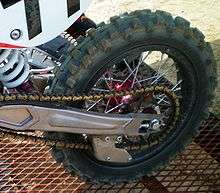Off-road tire

Off-road tires are a category of vehicle tires that use deep tread to provide more traction on unpaved surfaces such as loose dirt, mud, sand, or gravel.[1] Compared to ice or snow tires, they lack studs but contain deeper and wider grooves meant to help the tread sink into mud or gravel surfaces.
Design
Off-road tires are typically radials[2] with thick, deep tread. On dirt surfaces, the exposed edges of the tread dig into soft ground to more traction than rolling friction alone, analogous to the traction provided by cleated shoes. These off-road tires provide their maximum grip on loose surfaces, but on paved surfaces the smaller contact patch affords less traction as compared to street tires. Tires with less aggressive knobs (smaller knobs and the shape of the tread cross-section closer to that of street tires) can provide a compromise, giving less grip off-road, but a grip closer to that of street tires on paved surfaces. Such tires are useful for enduro and dual-sport motorcycles and other vehicles designed to be used both off-road and on pavement.
Some off road tires are designed to be used with low inflation pressure on difficult terrain, reducing their rigidity and allowing the tread to better conform to the terrain.[3] Such a design may allow for use on a wider range of surfaces, but tubeless tires running under rated pressure run the risk of breaking their bead. A beadlock can be used to prevent this.
Use on bicycles, motorcycles, and quads
Off-road cycle tires, colloquially called knobbies,[4] may be found on motocross and enduro motorcycles, ATVs, and mountain bikes.[1] Tires for single-track vehicles and ATVs have a curved profile such that some tread only contacts the ground during turning.
Depending on the model of tire, an off-road capable tire may or may not be approved by the DOT.[5] In the United States, such a tire approved for street use will be marked with a DOT code (U.S.), which identifies the tire as street legal. Tires which are not approved for street use will typically be labeled "Motocross Use Only" or "Not for Highway Use". Street legal, knobby tires are generally not suitable for long distances on roads or paved surfaces because of poor NVH properties and excessive wear on the soft rubber.
All-terrain
Depending on the design, an off-road tire may be designated "all terrain", meaning it is intended for use both on- and off-road. Such tires attempt to compromise between grip on loose terrain and safety or comfort on paved roads. Some tires, such as the bar grip used on United States military vehicles in World War II, accomplish this by separating the tire into distinct on-road and off-road tread zones. Modern all-terrain tires typically employ hybrid tread patterns and tougher compound to increase the wear life under mixed-surface conditions.[6]
See also
References
- 1 2 Wade Shaddy. "Knobby Vs. Street Bicycle Tires". AZCentral.com. Retrieved 2015-03-28.
- ↑ "Tire Construction Technology: Bias and Radial". FourWheeler.com. Retrieved 2016-11-17.
- ↑ "Off Road Facts". Dunlop Tires. Retrieved 2016-11-17.
- ↑ "Are Knobbies the Best Adventure Motorcycle Tires for Noobs?". AdvRider.com. Retrieved 2016-11-17.
- ↑ Andrew Tuttle. "Dirt Bike Tire Buying Guide". Motorsport.com. Retrieved 2016-11-17.
- ↑ "Highway All-Season or On-/Off-Road All-Terrain - Testing the Differences When Driving on Paved Roads". TireRack.com. 2015-10-16. Retrieved 2016-12-01.